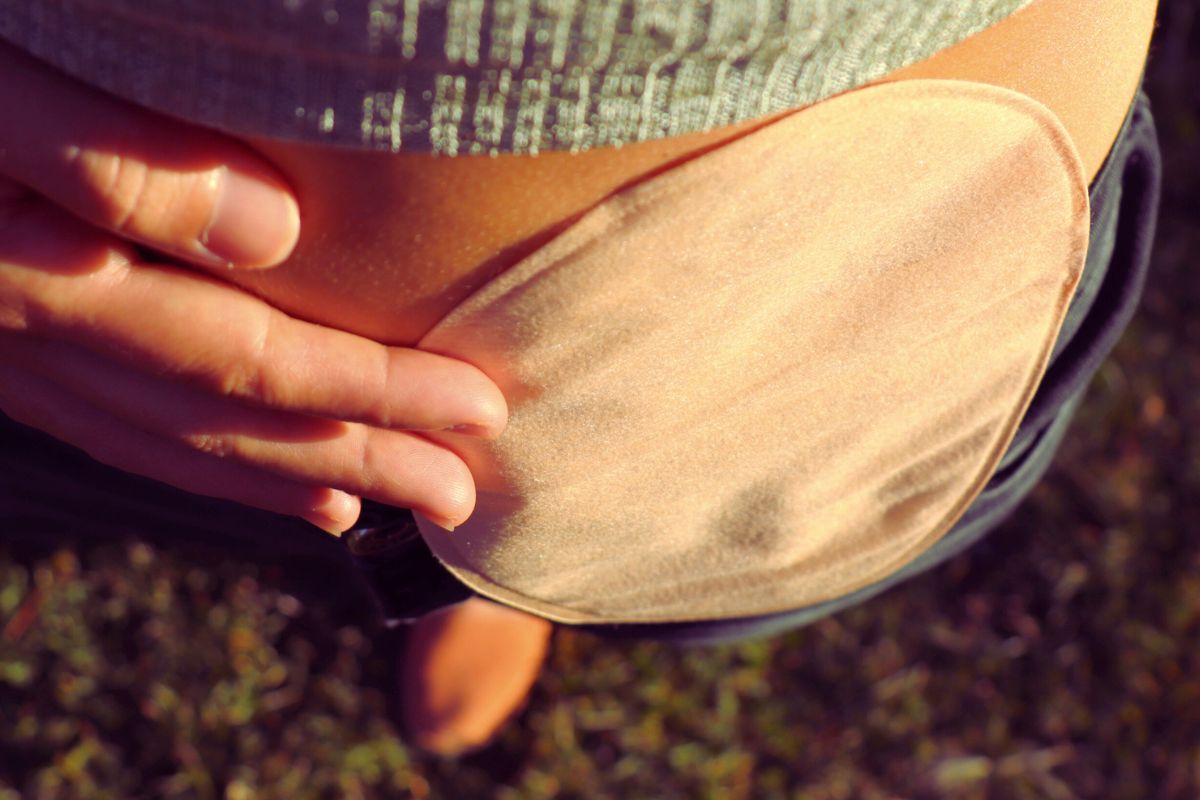Have you ever noticed undigested food in stoma output? Little bits of food—such as pasta, veggies, or corn—showing up in your stoma output? It can definitely catch you off guard the first time. The good news is, it’s not always something to panic about.
In this post, I’ll walk through why this happens, what’s considered normal, and when it might be a sign to check in with your care team. (I’m not a doctor, so always talk with your healthcare provider if you’re unsure or if symptoms become concerning.)

Understanding Partially Undigested Food in a Stoma
Sometimes, you’ll notice that certain foods appear in your pouch looking almost the same as when they went in. That doesn’t necessarily mean your digestion isn’t working—it’s often a combination of how the intestines process food and how fast things move through.
Why Some Pieces Remain Visible
Here are a few reasons food might show up in your output more recognizable than expected:
- Some foods just don’t break down easily.
Items like corn, mushrooms, and veggie skins are fibrous and resist full digestion even with thorough chewing. - Faster transit time.
Food can move through your shortened digestive tract more quickly after ostomy surgery, giving your body less time to break it down. - Anatomical changes.
Surgical adjustments, adhesions, or natural curves in the intestine can alter how food travels through, allowing some bits to pass intact.
If you’re not experiencing pain, bloating, or other discomfort, seeing a few small pieces here and there is usually considered normal.
Difference Between “Normal Fragments” vs. Worrisome Signs
Here’s a rough guide to undigested food in stoma:
| “Normal Fragments” | Signs That Warrant Attention |
|---|---|
| Occasional bits of soft pasta, small vegetable pieces, or skins | Frequent or increasing amounts of undigested food |
| No pain, cramping, bloating, or nausea | Cramping, abdominal pain, bloating, nausea, vomiting |
| Output still regular (volume and consistency not drastically changed) | Output slows considerably, gets watery only, or stops |
| No swelling around stoma or abdomen | Swelling of stoma or abdominal distension |
| No systemic symptoms | Signs of dehydration, reduced urine, dark urine, general malaise |
If undigested fragments are your only “issue,” and they happen occasionally without discomfort, many ostomates consider this tolerable. But you always want to watch for patterns or worsening signs.
When It’s Okay vs. When to See Your Provider
When It’s Okay
You’re likely fine if:
- It happens occasionally, not daily
- You feel well overall (no cramping, nausea, or bloating)
- Your output stays normal in volume and texture
- You notice it happens after certain foods (like fibrous veggies or skins)
- Chewing more thoroughly or drinking extra fluids helps
When to Seek Medical Attention
Call your healthcare provider if you notice:
- Persistent cramping, pain, or bloating
- Output slowing, becoming watery, or stopping
- Stoma or abdomen swelling
- Nausea or vomiting
- Dehydration signs (dark urine, dry mouth, dizziness)
- Symptoms that don’t improve with gentle changes
👉 Sources like Coloplast and Fittleworth note that symptoms such as cramping, swelling, watery stool, and decreased output can indicate a partial or full blockage.
Symptoms of a Food Blockage (or Bowel Obstruction)
Here are common symptoms to watch for, drawn from sources about stoma blockages and obstructions:
- Cramping or colicky abdominal pain
- Little or no stoma output (or only watery/mucus output)
- Swelling of the stoma or abdomen
- Nausea and vomiting
- Bloating or abdominal distension
- Signs of dehydration — reduced urine, dark urine, dry mouth, or dizziness
Thus, if you see a cluster of those symptoms, treat it seriously.
What “Partial Blockage” Might Look Like
A partial blockage means the bowel or stoma isn’t completely blocked—some liquid or soft content may still squeeze through, but solids struggle.
You might observe:
- Frequent watery or loose output (instead of your usual consistency)
- Reduced volume of output
- More discomfort/cramping than usual
- A “stalling” effect where output pauses for a while, then resumes irregularly
- Swelling or sensitivity around stoma or in abdomen
Tips to Help Reduce Undigested Food in Stoma
These are helpful strategies many ostomates and medical sources recommend:
Chew Thoroughly (Slow Down, Smaller Bites)
- Chewing well is essential: more surface area gives digestive enzymes a better chance to break food down.
- Take smaller bites, eat slowly, pause between bites.
- Focus on mastication, especially for tougher foods (e.g., fibrous veggies, bread crusts).
Hydrate Well (Liquids Help Smooth Passage)
- Adequate fluid intake helps soften and carry food particles through your intestines.
- Warm fluids may relax intestinal muscles and ease movement.
- During possible “stasis,” sip rather than gulp so you don’t compress food masses.
- sipping small amounts of fluid and avoiding large gulps is best.
Introduce Fiber / Fibrous Food Gradually
- After surgery, you’ll often start with low-fiber, gentle foods and gradually reintroduce fiber.
- Add one fibrous food at a time, in small portions, and observe how your body handles it.
- Avoid jumping into high-fiber meals all at once.
Consider Enzyme Aids / Digestive Supports (If Medically Advised)
- Some people find that digestive enzyme supplements (under medical supervision) help break down tougher food components.
- Probiotics or gut-friendly supplements might assist; always check with the medical team before using anything new.
- Don’t assume “more supplement = better” — follow your care team’s guidance.
Keep a Food & Symptom Diary to Spot Patterns
- Record what you eat (especially the suspect foods), portion size, how well you chewed, fluids consumed, and any digestive outcomes (undigested bits, discomfort, slowed output).
- Over weeks or months, this data can help you and your stoma nurse see trends (e.g. “pasta + poor chewing = issue”)
Foods More Likely to Pass Through or Cause Issues
While individual tolerance varies, these foods often show up in stoma blockage / undigested fragment reports:
- Mushrooms
- Corn / corn kernels
- Skins / peels (fruit skin, potato skin)
- Fibrous veggies (celery, asparagus, raw greens)
- Nuts, seeds, kernels
- Tough vegetable stalks (e.g. broccoli stems, stringy beans)
- Dried fruit, coconut, and popcorn
Tips for these foods:
- Peel skins or remove tough outer layers
- Cook thoroughly (soften fibers)
- Cut into small, bite-sized pieces
- Introduce in small amounts and observe response
These adjustments don’t guarantee avoidance but reduce risk. For more information read this informative guide: Foods to Avoid with an Ostomy: Prevent Blockages & Gas
What to Communicate to Your Doctor / Stoma Nurse
When you bring this issue up, these details help them assess:
- Frequency — how often do undigested bits show up?
- Associated symptoms — are there cramps, bloating, nausea, changes in output?
- Duration / pattern — is this a new thing, or increasing over time?
- What helps / worsens — e.g. fluids, chewing, rest
- Other symptoms — vomiting, swelling, changes to urine output, weight changes
- Your diet log / record — bring your food & symptom diary if you keep one
That gives the care team the best chance to diagnose whether it’s “just normal variation” or a signal of narrowing, blockage risk, or other complications.
Sometimes, seeing bits of macaroni, skins, or fibrous vegetable fragments in your stoma output is simply one of the quirks of digestion with an ostomy. It doesn’t necessarily indicate a problem, especially if it’s occasional, mild, and not accompanied by discomfort.
That said, when it’s frequent, worsening, or associated with troubling symptoms (pain, bloating, reduced output, vomiting, swelling, dehydration), it’s smart to seek medical input.
I am not a doctor, so use this as a guide to help you understand the possibilities, and keep in mind that I always encourage you to consult your care team if you’re concerned.
Don’t forget to sign up for the free newsletter and follow along on social media so you never miss another post again.

